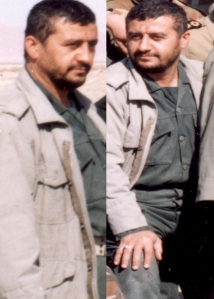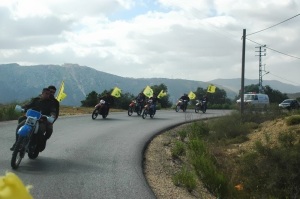Dutch TV reporter Roozbeh Kaboly and the Nieuwsuur team have put together this report, with English subtitles, based on a video said to show Iranian troops training militia in Syria, using a village school as a base. The man being interviewed has been identified as Revolutionary Guards Commander Esmail Heydari, who reportedly died in Syria a few weeks ago, and was later given a public funeral in his hometown of Amol, about 180km north of Iran’s capital, Tehran. He describes the mission, working with teams which are on 25-day rotation, adding that some were previously trained in Iran. Part of the mission’s objective appears to be securing access for Hezbollah to deliver weapons and supplies.

Esmail Heydari| Photo: http://fajrenoor.blogfa.com/
Followers of human rights abuses in Iran, used to reading about the indescribable torture and cruelty dispensed to prisoners in the “special” IRGC detention centres and isolation wards, may be surprised by the smiling, relaxed, countenance of this commander. Heydari reveals the secret of his team’s success on their training mission is that they treat fighters with respect, “We haven’t paid them or anything,” he comments. Respect is a sentiment Heydari claims to extend to the local people: for example, by driving military vehicles slowly in civilian areas to avoid raising dust. While driving through a village Heydari says was deserted until his unit came to the area and cleaned up, he greets children warmly, offering candy. “When we came, there was no human being,” says Heydari. One of his team responds, “There are still no humans now, just Arabs.” The Nieuwsuur translation then relates the cameraman suggesting the Iranians also offer candy to the women they are passing on the road, but misses what I consider to be an implied threat in the reply: “We’ll give them some(thing), and you can film.” This is more typical of the IRGC behaviour I am familiar with.
The regime in Iran celebrated his death by burying Commander Heydari with honor, as a martyr who died defending the Shrine of Syeda Zainab, granddaughter of the prophet Mohammed.
At least 6 more videos were posted to YouTube by the admin of a rebel group’s Facebook page, and were later verified by France24 journalists working with translators, who helped to produce a detailed analysis. The links to the original videos were shared on Twitter, but were either shared only with selected contacts, or the settings were later changed to prevent public access. Copies of the videos, which seem to show Iranian military officers working with soldiers from Syria’s regular army, giving them advice and instructions for combat, can be seen here.
The film appears to have been recorded by Hadi Baghbani, a young Iranian documentary maker, who reportedly died during an incident on the outskirts of Damascus, Syria, where he is said to have been on a 10-day assignment, his second such visit. A second group of Iranians reportedly died while on the road in Syria, either because of a traffic accident or because their driver was killed by a sniper. The rebels believed to have found Baghbani’s video camera, the Idblib-based Dawood Brigade, which released the video, claimed responsibility for “most” of the deaths in an interview with al-Aan TV. The group’s spokesperson, Hosam Alsermene, told Al-Jazeera that they killed about 15-20 members of an Iranian team after hearing about their Syrian operations. Their identities and operational details were confirmed after taking possession of mobile phones and the video camera of an independent journalist who just happened to be there. The 30-year-old filmmaker received a burial ceremony in his hometown of Babolsar, Iran.
It’s not completely clear, from the available accounts, how the bodies were returned to Iran. Can we assume that this happened with the help of Syrian authorities or the militia which were being trained? Alternatively, other Iranians still present in Syria might have been able to repatriate the dead themselves.
Defending the Shrine of Syeda Zainab
In July 2012, it was reported that about 5,000 Shiite Muslims were living in the neighbourhood of the shrine, including some who fled there to seek refuge from sectarian violence. Local youths armed with sticks were said to be defending the site, with Iran alleging clerics in Saudi Arabia had issued a fatwa demanding its destruction. A group of 48 Iranians, including members of the IRGC who claimed they were in retirement and making a pilgrimage to the shrine, was taken hostage in August 2012, before being traded in exchange for 2,130 prisoners of the Syrian regime in January 2013. Abdel Nasser Shmeir, interviewed by Al Arabiya and presented as the commander of Al-Baraa Brigade, claimed the hostages, plus their Afghan interpreter, were members of a 150-strong group sent to Syria by Iran for reconnaissance and intelligence-gathering. Shia news organisations claim that the shrine is now being protected by hundreds of Shia militants from Iraq and the Lebanese Hezbollah group. Recent reports say a custodian of the site, Anas Romani, was killed, and the building damaged, when it was attacked by mortar shells in July 2013. The Syrian government accused militants of the attacks.
Filed under: FaceBook, Interesting, Internet, Iran, Lebanon, Syria, Twitter, Updates, Video Tagged: Amol, Babolsar, Damascus, Iran, Syria
via @lissnup on WordPress


No comments:
Post a Comment
Note: only a member of this blog may post a comment.